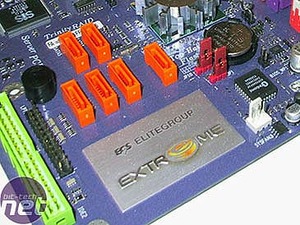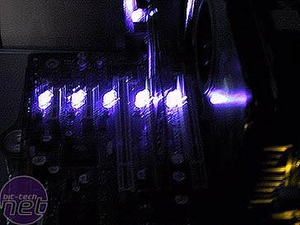ECS PF21 Extreme - The Board
 The rather fetching metallic purple PCB isn’t really as bad as you’d expect, although it isn’t really to our tastes. It’s probably made worse by the lack of colour theme/co-ordination (or general over-use of every other basic colour under the sun). In general the board is as well laid out as any other motherboard we've reviewed, with all of the important connectors around the edges for the easiest access. However, there are a few niggles that we will come to as we work our way around the motherboard.
The rather fetching metallic purple PCB isn’t really as bad as you’d expect, although it isn’t really to our tastes. It’s probably made worse by the lack of colour theme/co-ordination (or general over-use of every other basic colour under the sun). In general the board is as well laid out as any other motherboard we've reviewed, with all of the important connectors around the edges for the easiest access. However, there are a few niggles that we will come to as we work our way around the motherboard.
The northbridge is actively cooled by a significant slab of aluminium that seems to have been inspired by the old Thermaltake Orb CPU coolers. Although it isn’t as big as the Thermaltake CPU coolers, it is quite tall compared to a typical northbridge heatsink at almost 35mm high. Unfortunately the fan was the loudest in the whole system by a good margin. The southbridge is passively cooled by another solid circular piece of aluminium with the lettering “extreme” cut out of the edges. While this doesn’t really aid the cooling as well as a heatsink with a large surface area, it does help a little and just adds to the "extreme" ethos that ECS are trying to fill you with, as it is displayed no less than 3 times across the motherboard.
Down the right hand side we have the 24-pin ATX power connector, which is backward compatible with standard 20-pin power supplies, while the 12V, 4-pin power connector is nestled between northbridge heatsink, power regulation components and the back I/O panel - this means that you have to route the cable around the CPU heatsink, and would have been better placed on the edge of the motherboard for tidier cabling.
The lime green single native ATA133 and a black floppy ports are adjacent to the DDR2 memory slots, which are colour co-ordinated orange and purple according to memory channel. The board supports a maximum of four DDR2 memory modules (1.8v, 400/533MHz, 240-pin, 4GB max).
Just in case you forget what manufacturer you purchased there’s a nice waste/use of PCB space below this with a big ECS Extreme sticker on it. Around the badge, there is the BIOS chip, six SATA ports – four are controlled by the Intel ICH6R southbridge, while the remaining two are controlled by the SIS 180 controller chip. To the right of the badge there is another ATA133 port, also controlled by the SIS disk controller. Along the right hand edge of the board, there are headers for Firewire, USB 2.0, and front audio.

 The PCI-Express x16 slot is relatively obstruction free and there are no capacitors to hamper the installation of longer video cards. However, the memory slots are quite close to the top of the video card when a GeForce 6800 GT was installed, so care is needed when installing video card so as not to accidentally remove surface components from the back of the card. To the right of this are the three legacy PCI slots and two PCI-Express x1 slots. The yellow “PCI Extreme” slot (We didn’t see that name coming did we? - Ed.) is specifically coloured differently for a reason: it’s a special slot that has it’s own power and data lines to provide maximum clarity in signal. This should be used when overclocking, as it should provide more tolerance. During testing, we found that putting our Belkin WiFi card in this slot gave a better signal to noise ratio and a better, more stable connection than compared to the other slots and to other boards. The board was placed in exactly the same place as other boards tested so we are confident the special yellow PCI slot does exactly what it says on the tin.
The PCI-Express x16 slot is relatively obstruction free and there are no capacitors to hamper the installation of longer video cards. However, the memory slots are quite close to the top of the video card when a GeForce 6800 GT was installed, so care is needed when installing video card so as not to accidentally remove surface components from the back of the card. To the right of this are the three legacy PCI slots and two PCI-Express x1 slots. The yellow “PCI Extreme” slot (We didn’t see that name coming did we? - Ed.) is specifically coloured differently for a reason: it’s a special slot that has it’s own power and data lines to provide maximum clarity in signal. This should be used when overclocking, as it should provide more tolerance. During testing, we found that putting our Belkin WiFi card in this slot gave a better signal to noise ratio and a better, more stable connection than compared to the other slots and to other boards. The board was placed in exactly the same place as other boards tested so we are confident the special yellow PCI slot does exactly what it says on the tin.
Underneath each PCI/PCI-Express slot is a 3mm blue LED that indicates if a PCI card is plugged into the port above it. It is supposed to alert users to improperly plugged in PCI cards and we suppose this can be helpful and they are a nice colour, but because it cannot differentiate between nothing being installed and an improperly installed PCI card it just flashes… constantly. So, with no PCI cards installed you are greeted with five LEDs all blinking at you without any way to turn them off. This got extremely annoying after a while and it would have made more sense to only turn them on when something is plugged in as confirmation, or, even better: underlight the PCI slot so you get not only soft lighting, but also knowing which PCI slot it is instead of having to guess if the LED means the one above or one below. Having the LED between two PCI slots means you can easily mistake which slot has the problem if both are populated above and below the LED.

The northbridge is actively cooled by a significant slab of aluminium that seems to have been inspired by the old Thermaltake Orb CPU coolers. Although it isn’t as big as the Thermaltake CPU coolers, it is quite tall compared to a typical northbridge heatsink at almost 35mm high. Unfortunately the fan was the loudest in the whole system by a good margin. The southbridge is passively cooled by another solid circular piece of aluminium with the lettering “extreme” cut out of the edges. While this doesn’t really aid the cooling as well as a heatsink with a large surface area, it does help a little and just adds to the "extreme" ethos that ECS are trying to fill you with, as it is displayed no less than 3 times across the motherboard.
Down the right hand side we have the 24-pin ATX power connector, which is backward compatible with standard 20-pin power supplies, while the 12V, 4-pin power connector is nestled between northbridge heatsink, power regulation components and the back I/O panel - this means that you have to route the cable around the CPU heatsink, and would have been better placed on the edge of the motherboard for tidier cabling.
The lime green single native ATA133 and a black floppy ports are adjacent to the DDR2 memory slots, which are colour co-ordinated orange and purple according to memory channel. The board supports a maximum of four DDR2 memory modules (1.8v, 400/533MHz, 240-pin, 4GB max).
Just in case you forget what manufacturer you purchased there’s a nice waste/use of PCB space below this with a big ECS Extreme sticker on it. Around the badge, there is the BIOS chip, six SATA ports – four are controlled by the Intel ICH6R southbridge, while the remaining two are controlled by the SIS 180 controller chip. To the right of the badge there is another ATA133 port, also controlled by the SIS disk controller. Along the right hand edge of the board, there are headers for Firewire, USB 2.0, and front audio.


Underneath each PCI/PCI-Express slot is a 3mm blue LED that indicates if a PCI card is plugged into the port above it. It is supposed to alert users to improperly plugged in PCI cards and we suppose this can be helpful and they are a nice colour, but because it cannot differentiate between nothing being installed and an improperly installed PCI card it just flashes… constantly. So, with no PCI cards installed you are greeted with five LEDs all blinking at you without any way to turn them off. This got extremely annoying after a while and it would have made more sense to only turn them on when something is plugged in as confirmation, or, even better: underlight the PCI slot so you get not only soft lighting, but also knowing which PCI slot it is instead of having to guess if the LED means the one above or one below. Having the LED between two PCI slots means you can easily mistake which slot has the problem if both are populated above and below the LED.

MSI MPG Velox 100R Chassis Review
October 14 2021 | 15:04






Want to comment? Please log in.